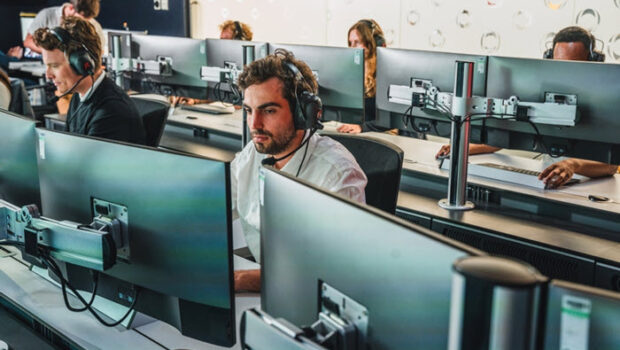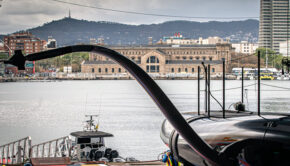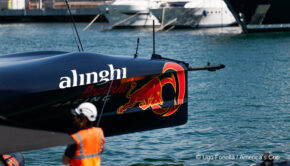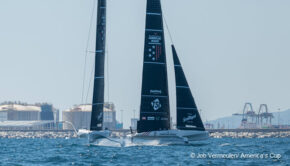Buying time to win the America’s Cup
Published on January 19th, 2024
British America’s Cup challenger shares how they are providing technical support in preparation for the 37th America’s Cup:
Four decades ago, going all the way back to the 12 Metre era in Newport, USA, the engineering support for an America’s Cup boat amounted to a fast RIB back at the sailing base and a VHF radio. Most of the things that went wrong could be fixed on the water by the sailors. Every now and again a spare part might be required, and the RIB was there to bring it out to the yacht. Anything more serious ended the day’s sailing.
A couple of decades later and things had heated up with the arrival of the International America’s Cup Class (IACC). The engineering was more complex and closer to the margins. The sailors spent more time training and sailing, and a lot less time working on the boats. As a consequence, more of the engineering support had moved out onto the water. Electronics, winch and hydraulic engineers spent the day — ready to spring into action — on a big, comfortable support boat well-stocked with spares.
Another two decades on and the IACC has given way to foiling, flying monohulls, and the engineering complexity and the back-up required has gone up several more notches. The technical demands of the boats now requires an unprecedented level of support for the sailing operations. A full phalanx of engineers is now out on the water, but the complexity of the boats demands something more — F1 standards of remote engineering support.
INEOS Britannia’s testing boat T6 is packed with sensors and technology, measuring loads and motion hundreds or even thousands of times a second. Video channels send the viewpoint of multiple cameras, monitoring every moment of the fluid flow over the aerofoils and hydrofoils. All this data goes into SIM cards connected to a 5G network, and is then transferred by an assured 1Gbps MPLS fibre link to the Sailing Support Room (SSR) at the Mercedes F1 base in Brackley, England.
“The Sailing Support Room, or Mission Control, is a bit of a step up for us from previous campaigns,” commented Dave Endean, Chief Operations Officer for the team. “It enables us to have eight or nine engineers based here in Brackley, supporting the operations wherever they happen to be. We’ve got full live data and video feedback. In the past this has always had a time delay which meant that this sort of support was impossible.
“The key to the system working is that the boat can talk direct to the engineers in Brackley, and the engineers can talk direct to them. When the guys on board have questions, the engineers in the SSR can hear them talking, and they can work out the answers to their questions on the spot. It makes the learning curve on the water that much steeper, they can get information they need when they need it. They don’t have to make assumptions. They can get their questions answered in real time.
“In practice, we keep the chatter down as much as we can, the sailors will talk to the coaching staff, and maybe a couple of engineers on the water who are controlling the tests that we’re executing that day. We want to make sure that the boat communication is as quiet as possible because the sailors need the audio channel to talk to each other, to make sure that they get the boat around the track as smoothly as possible and as fast as they can.
“So we keep all the other noise down, but if Ben wanted to talk to Joe about an aspect of the control system, he could push a button and Joe could talk directly back to him to answer his question. It opens up the big organization back here in Brackley to fully support what’s happening in Palma. Although we need to do shifts in here, to support the unusual sailing hours that we need to get on the water when the wind’s right!”
The legendary US investor Warren Buffet said of time, “It’s the only thing you can’t buy.” And while that may have been true for Buffet, the Sailing Support Room has bought the team extra time on the water. The extra efficiency means that almost every moment of the limited sailing time can be used effectively. Engineering support for the AC75 has come a long way from the VHF radio and RIB enjoyed by the 12Ms, but then, so has almost everything else in the America’s Cup.
Following the publication of the AC37 Protocol and AC75 Class Rule on November 17, 2021, the AC75 Class Rule and AC Technical Regulations were finalized on March 17, 2022. The entry period opened December 1, 2021 and runs until July 31, 2022, but late entries for the 37th America’s Cup may be accepted until May 31, 2023. The Defender was to announce the Match Venue on September 17, 2021 but postponed the venue reveal, confirming it would be Barcelona on March 30, 2022. The 37th America’s Cup begins October 12, 2024.
Teams revealed to challenge defender Emirates Team New Zealand (NZL):
• INEOS Britannia (GBR)
• Alinghi Red Bull Racing (SUI)
• Luna Rossa Prada Pirelli Team (ITA)
• NYYC American Magic (USA)
• Orient Express Racing Team (FRA)
2023-24 Preliminary Regattas
September 14-17, 2023 (AC40): Vilanova i la Geltrú, Spain
November 30-December 2 (AC40): Jeddah, Saudi Arabia
August 22-25, 2024 (AC75): Barcelona, Spain
2024 Challenger Selection Series
August 29-September 8: Round Robins
September 14-19: Semi Finals
September 26-October 5: Finals
2024 America’s Cup
October 12-21: 37th Match (Best of 13)
Additionally, 12 teams will compete in the 2024 Youth & Women’s America’s Cup.
Noticeboard: https://ac37noticeboard.acofficials.org/
Additional details: www.americascup.com/en/home









 We’ll keep your information safe.
We’ll keep your information safe.